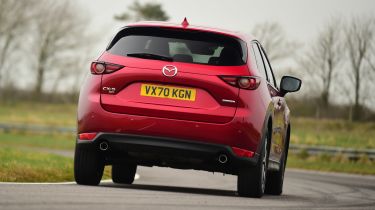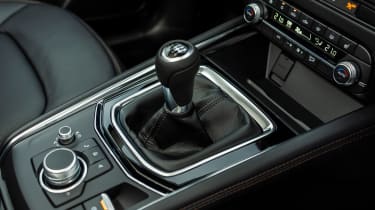Mazda CX-5 SUV - Engines, drive & performance
Engaging driving manners are key to the Mazda CX-5 experience
Without beating around the bush, the way the CX-5 drives is one of its strongest suits. If you’re moving to an SUV from a hatchback like a Ford Focus and are afraid you’ll miss out on driving fun, the CX-5 should be high on your shortlist of candidates.
This is despite the fact that, like all SUVs, physics really aren’t in its favour. It’s a long, wide and reasonably heavy car, so there are significant forces for its suspension and brakes to keep under control. Nevertheless, you wouldn't know it because the Mazda responds obediently to commands through the steering wheel and pedals – the steering is accurate and satisfyingly weighty and there’s lots of grip from the tyres, so fast corners can be taken with confidence.
The Mazda’s 1,500kg weight is borne out by a greater tendency to lean in corners than you’ll notice in a lighter hatchback, and this is exacerbated by its greater ride height. That said, it doesn’t detract from the experience and the CX-5 changes direction more swiftly than almost all its rivals. We rate the CX-5 as among the most nimble of all the mainstream SUVs, so it’s the one we recommend if driver appeal is on your priority list.
More reviews
In-depth reviews
Used car reviews
Perhaps more relevant is the fact that fun behind the wheel doesn’t come at the expense of passenger comfort, especially with the entry-level 17-inch alloy wheels. Here, ride quality is pliant, if a little firmer than some rivals – certainly a big improvement on the comfort of the previous model. Versions fitted with 19-inch wheels aren’t quite as soft over bumps, but still far from uncomfortable. The new 2022 CX-5 gets a tweaked suspension setup to make it more pliant, with new dampers that have been even more expertly tuned.
The standard gearbox is a six-speed manual, which has a very slick shift action and is, we reckon, more pleasurable than the six-speed automatic alternative, feeling quite similar to that found in the Mazda MX-5 sports car. The automatic also adds considerable expense while dropping fuel economy and increasing emissions, but it’s otherwise adequate and will appeal to anyone who spends most of their time driving in heavy traffic.
Mazda CX-5 diesel engines
The engine lineup is largely carried over from the previous model, albeit with various minor tweaks to keep them up-to-date. The diesel lineup now consists of just one power output: the 182bhp version of a 2.2-litre twin-turbocharged four-cylinder engine, which has been proven in several Mazda cars. Previously there was a 148bhp version of the same engine but this is no longer offered.
When we tested the 182bhp engine, we found it to be quieter and smoother than it had been in the previous CX-5, but its pulling power is as impressive as ever – 0-62mph takes just over nine seconds in manual form. For a diesel engine, it seems very keen to rev and is responsive when you make sudden demands, such as when overtaking slower traffic.
Petrol engines
The 2.0-litre four-cylinder petrol engine has 163bhp and is offered with either a six-speed manual gearbox or an automatic transmission. Its key appeal is that it’s by far the least expensive engine in the range, and low-mileage drivers (below 12,000 a year or so) are likely to find it no more expensive to run than a diesel. It’s quieter than the diesels at tickover when cold, too, although the diesels are just as quiet when you reach cruising speeds.
This petrol engine can’t quite match the pulling power of the diesel, and its more muscular feel means it suits the CX-5 rather better. Getting from 0-62mph takes 10.7 seconds in the manual, while the automatic is actually a bit quicker, managing the dash in 10.2 seconds.
The 2.0-litre petrol feels a bit gutless lower down the rev range because it goes without a turbocharger and has less pulling power than its rivals. Overtaking slow-moving vehicles will take at least one downshift, and most of the power comes in high up the rev range. That means you will often need to keep the throttle pressed down long after a gear change, unlike in some rivals, which harms fuel economy. But overlook this, and the CX-5 will leave a smile on your face.
There’s also a 2.5-litre petrol engine available only on the top-spec Takumi model. This gets 191bhp and is solely available with an automatic gearbox. This does 0-62mph in 9.5 seconds, but in testing, we thought it felt more sluggish than anticipated. It can take a while to get used to how hard the Mazda’s 2.5-litre needs to be worked to extract its performance. The 2.0-litre TSI engine in the Skoda Karoq has more torque and gets it from 0-62mph nearly two seconds faster. This isn’t helped by the sluggish six-speed automatic gearbox, which isn’t as snappy as the Skoda’s dual-clutch DSG transmission. Mazda’s biggest petrol is less refined too, so we'd avoid it and go for the 2.2-litre diesel, which feels far better suited to the CX-5.










